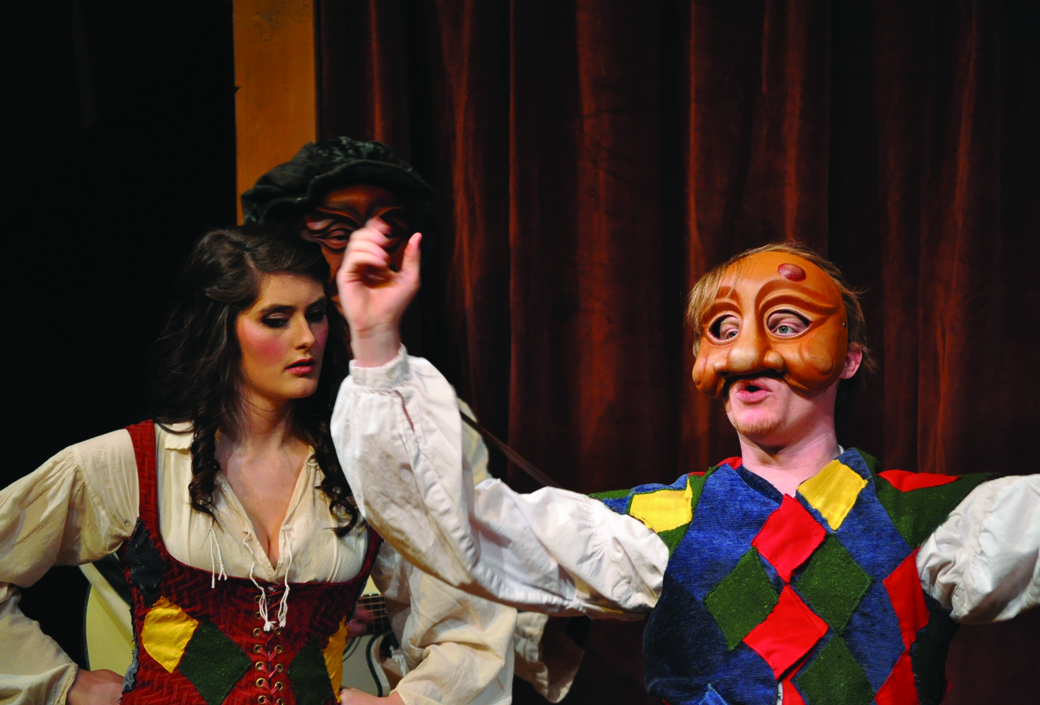
Classical production promises humor
The University of South Dakota Theater Department is bringing an art form born hundreds of years ago in Italy to the Vermillion stage with its production of the comedy ‘The Servant of Two Masters.’
Director of the play and assistant professor of theater, Chaya Gordon-Bland said the ‘The Servant of Two Masters’ — a Commedia dell’Arte play that takes place in 16th century Venice — brings to life the characters in a contemporary and accessible way.
The theatrical style of Commedia dell’Arte uses masks, music, physical comedy and improvisation.
“In today’s popular culture the influences of Commedia dell’Arte can be seen in places as diverse as ‘That 70’s Show’ and ‘The Simpsons,'” she said.
Other plays Gordon-Bland said that bear the influence of Commedia dell’Arte include Punch and Judy, Shakespeare, Moliere, mime, silent film and slapstick comedy.
First-year Allie Verry plays the character Clarice in the comedy and said she has enjoyed learning a new style of acting.
“Before this show I had never heard of Commedia Dell’Arte, and being able to envelope myself in this style of theatre has been a great experience for me,” she said. “This show will be incredibly entertaining for students. It’s something new for them to see, and it’s hilarious. There have been times watching my other cast members do their scenes where I have fallen to the ground laughing.”
Senior Emily Dorsett, who plays Beatrice Rasponi, said the improvised moments throughout the show encourage audience participation.
“We’ve pretty much been experimenting with it and whatever we like, we keep,” she said. “There’s forbidden love, running contraband, lost love, secrets and lies, friendship, loyalty and a sword fight. It has everything. Students should see this play because it is hilarious.”
The production tells the story of Truffaldino, a hungry and resourceful servant, who seeks employment with two masters in order to double his earnings and his ‘eatings.’ Truffaldino’s efforts to pull off this scheme unbeknownst to either master results in antics, comedy and theatrical chaos of the best kind, Gordon-Bland said.
Gordan-Bland said the comedy is the capstone project to a three-year research endeavor into the practice and pedagogy of Commedia dell’Arte, funded in part by a Track to Success grant from USD’s Office of Research and Sponsored Programs, the College of Fine Arts and the Department of Theatre.
“This play was selected for the opportunity it provides to explore the Commedia dell’Arte style in production and to share this unique style of work with audiences,” she said.
To support this work in production, Gordan-Bland said, a special course was offered in the theater department in the fall semester which focused on the particular demands and opportunities of performing Commedia dell’Arte. She said approximately half of the cast in the production participated in this course in the fall.
Gordan-Bland said the cast for the play is brave, bold, playful and highly collaborative.
“Every night they bring new ideas into the space,” she said. “They listen to and support each other, they play well with each other both on and off-stage and they take beautiful risks. The cast has boldly stepped into the heritage of Commedia dell’Arte and are now a living, breathing part of the present and future of the art form.”
Although most plays are generally performed in the Wayne S. Knutson Theater, ‘The Servant of Two Masters’ will be performed in the Arena Theater March 26-28 at 7:30 p.m. and March 30 at 2 p.m.
Gordan-Bland said the different theater was chosen for a variety of reasons, including flexibility.
“In directing this production I was interested in re-creating the feeling that audiences might have had in seeing a Commedia performance outdoors in the piazzas of 16th century Italy,” she said. “I wanted the relationship between audience and actor to be intimate, and I wanted the audience to feel involved with the performance.”
Gordan-Bland said the audience literally wraps around the stage, and that the cast and crew is also using the aisles through the audience as part of the performance space.
“The performance space and the audience space are actually shared,” she said. “Both the scenic and lighting designs support this concept of a shared space that directly involves the audience in the performance.”

